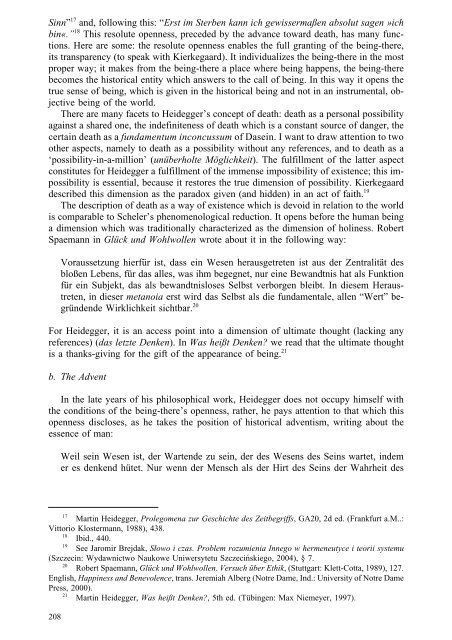[Andrzej_Wiercinski_(ed ... - WordPress.com
[Andrzej_Wiercinski_(ed ... - WordPress.com
[Andrzej_Wiercinski_(ed ... - WordPress.com
You also want an ePaper? Increase the reach of your titles
YUMPU automatically turns print PDFs into web optimized ePapers that Google loves.
Sinn” 17 and, following this: “Erst im Sterben kann ich gewissermaßen absolut sagen »ichbin«.” 18 This resolute openness, prec<strong>ed</strong><strong>ed</strong> by the advance toward death, has many functions.Here are some: the resolute openness enables the full granting of the being-there,its transparency (to speak with Kierkegaard). It individualizes the being-there in the mostproper way; it makes from the being-there a place where being happens, the being-therebe<strong>com</strong>es the historical entity which answers to the call of being. In this way it opens thetrue sense of being, which is given in the historical being and not in an instrumental, objectivebeing of the world.There are many facets to Heidegger’s concept of death: death as a personal possibilityagainst a shar<strong>ed</strong> one, the indefiniteness of death which is a constant source of danger, thecertain death as a fundamentum inconcussum of Dasein. I want to draw attention to twoother aspects, namely to death as a possibility without any references, and to death as a‘possibility-in-a-million’ (unüberholte Möglichkeit). The fulfillment of the latter aspectconstitutes for Heidegger a fulfillment of the immense impossibility of existence; this impossibilityis essential, because it restores the true dimension of possibility. Kierkegaarddescrib<strong>ed</strong> this dimension as the paradox given (and hidden) in an act of faith. 19The description of death as a way of existence which is devoid in relation to the worldis <strong>com</strong>parable to Scheler’s phenomenological r<strong>ed</strong>uction. It opens before the human beinga dimension which was traditionally characteriz<strong>ed</strong> as the dimension of holiness. RobertSpaemann in Glück und Wohlwollen wrote about it in the following way:Voraussetzung hierfür ist, dass ein Wesen herausgetreten ist aus der Zentralität desbloßen Lebens, für das alles, was ihm begegnet, nur eine Bewandtnis hat als Funktionfür ein Subjekt, das als bewandtnisloses Selbst verborgen bleibt. In diesem Heraustreten,in dieser metanoia erst wird das Selbst als die fundamentale, allen “Wert” begründendeWirklichkeit sichtbar. 20For Heidegger, it is an access point into a dimension of ultimate thought (lacking anyreferences) (das letzte Denken). In Was heißt Denken? we read that the ultimate thoughtis a thanks-giving for the gift of the appearance of being. 21b. The AdventIn the late years of his philosophical work, Heidegger does not occupy himself withthe conditions of the being-there’s openness, rather, he pays attention to that which thisopenness discloses, as he takes the position of historical adventism, writing about theessence of man:Weil sein Wesen ist, der Wartende zu sein, der des Wesens des Seins wartet, indemer es denkend hütet. Nur wenn der Mensch als der Hirt des Seins der Wahrheit des17Martin Heidegger, Prolegomena zur Geschichte des Zeitbegriffs, GA20, 2d <strong>ed</strong>. (Frankfurt a.M..:Vittorio Klostermann, 1988), 438.18Ibid., 440.19See Jaromir Brejdak, Słowo i czas. Problem rozumienia Innego w hermeneutyce i teorii systemu(Szczecin: Wydawnictwo Naukowe Uniwersytetu Szczecińskiego, 2004), § 7.20Robert Spaemann, Glück und Wohlwollen. Versuch über Ethik, (Stuttgart: Klett-Cotta, 1989), 127.English, Happiness and Benevolence, trans. Jeremiah Alberg (Notre Dame, Ind.: University of Notre DamePress, 2000).21Martin Heidegger, Was heißt Denken?, 5th <strong>ed</strong>. (Tübingen: Max Niemeyer, 1997).208


